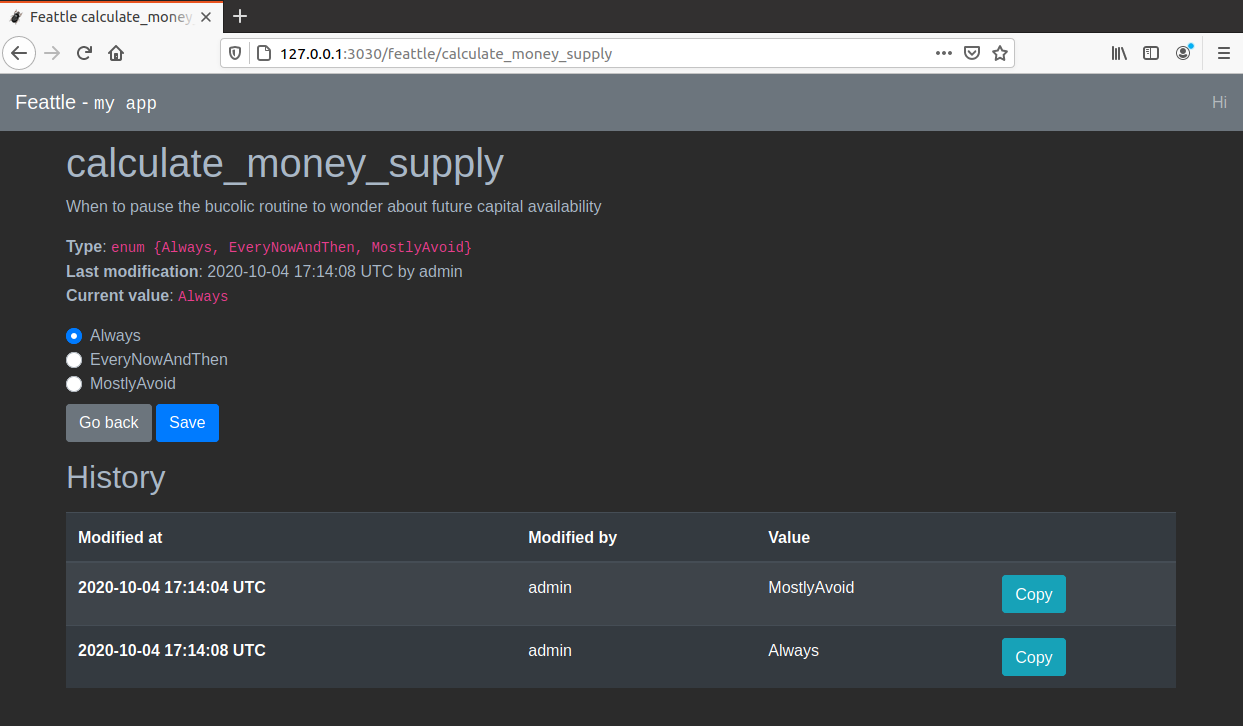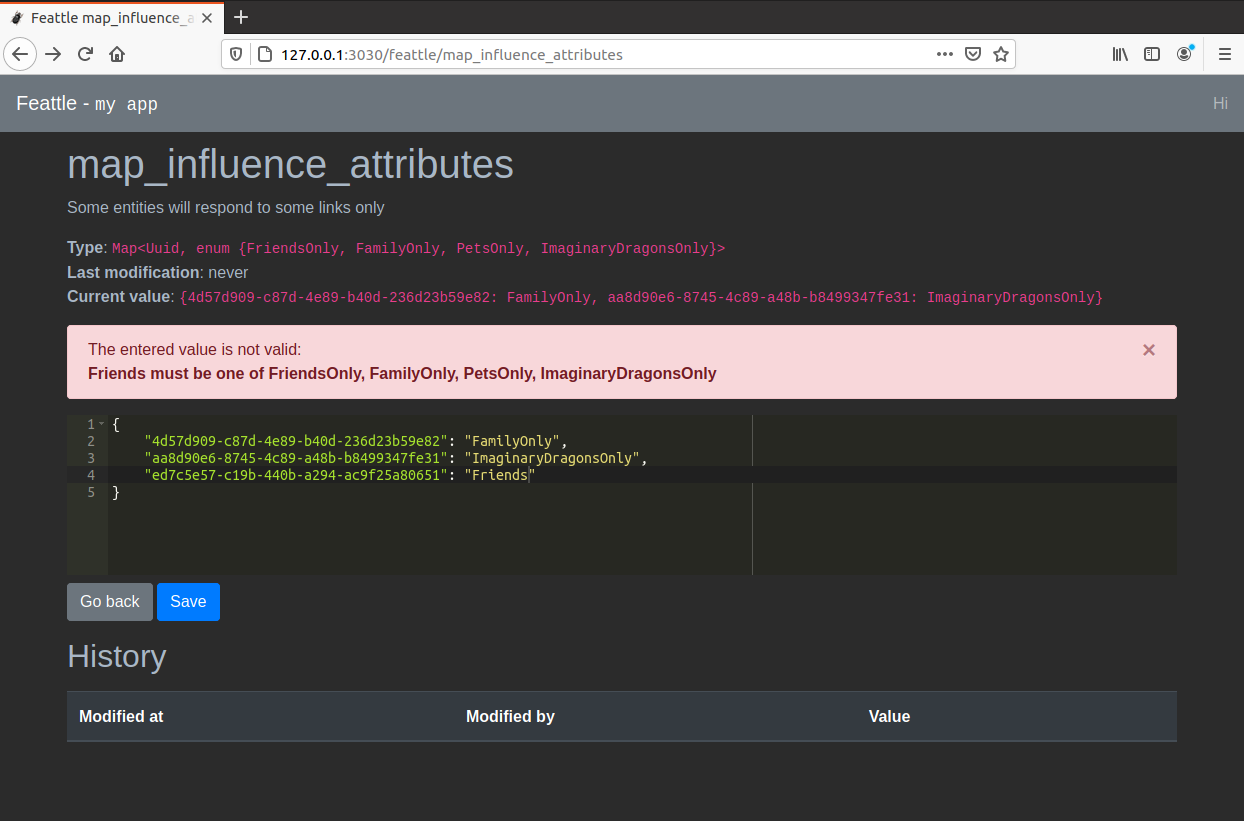Featture toggles for Rust (called "feattles", for short), extensible and with background synchronization and administration UI.
- Feature toggles that synchronize automatically with a backing storage
- Feature toggles can be as simple
bool, but can also be lists, maps and arbitrary tpes ( (through the [FeattleValue] trait). - Web UI with documentation, change history, validation
- JSON API to read and set the toggles
- Modular and extensible: use as much or as little of the bundled features as you want. Want to use a different Web UI? A different storage layer? No problem.
use feattle::*;
use std::sync::Arc;
/// A struct with your feature toggles: you can use primitive types (like `bool`, `i32`, etc),
/// standard collections (like `Vec`, `BTreeSet`, etc) or any arbitrary type that implements
/// the required trait.
feattles! {
struct MyFeattles {
/// Is this usage considered cool?
is_cool: bool = true,
/// Limit the number of "blings" available.
/// This will not change the number of "blengs", though!
max_blings: i32,
/// List the actions that should not be available
blocked_actions: Vec<String>,
}
}
#[tokio::main]
async fn main() {
// Store their values and history in AWS' S3
use std::future::IntoFuture;
use std::time::Duration;
use tokio::net::TcpListener;
let config = aws_config::load_from_env().await;
let persistence = Arc::new(S3::new(
&config,
"my-bucket".to_owned(),
"some/s3/prefix/".to_owned(),
));
// Create a new instance
let my_feattles = Arc::new(MyFeattles::new(persistence));
// Poll the storage in the background
BackgroundSync::new(&my_feattles).start().await;
// Start the admin UI with `warp`
let admin_panel = Arc::new(AdminPanel::new(my_feattles.clone(), "Project Panda - DEV".to_owned()));
tokio::spawn(run_warp_server(admin_panel.clone(), ([127, 0, 0, 1], 3030)));
// Or serve the admin panel with `axum`
let router = axum_router(admin_panel);
let listener = TcpListener::bind(("127.0.0.1", 3031)).await.unwrap();
tokio::spawn(axum::serve(listener, router.into_make_service()).into_future());
// Read values (note the use of `*`)
assert_eq!(*my_feattles.is_cool(), true);
assert_eq!(*my_feattles.max_blings(), 0);
assert_eq!(*my_feattles.blocked_actions(), Vec::<String>::new());
}You can run a full example locally with: cargo run --example full --features='s3 uuid warp axum'.
With this code, you'll get an Web Admin UI like:
You can use the UI to edit the current values and see their change history. For example, this
is what you can expect when editing an enum:
It also supports complex types with a JSON editor and helpful error diagnostics:
The macro will generate a struct with the given name and visibility modifier (assuming private
by default). The generated struct implements [Feattles] and also exposes one method for each
feattle.
The methods created for each feattle allow reading their current value. For example, for a
feattle is_cool: bool, there will be a method like
pub fn is_cool(&self) -> MappedRwLockReadGuard<bool>. Note the use of
[parking_lot::MappedRwLockReadGuard] because the interior of the struct is stored behind a RwLock to
control concurrent access.
A feattle is created with the syntax $key: $type [= $default]. You can use doc coments (
starting with ///) to describe nicely what they do in your system. You can use any type that
implements [FeattleValue] and optionally provide a default. If not provided, the default
will be created with Default::default().
As of this release, the MSRV is 1.76.0, as tested in the CI. A patch release will never require a newer MSRV.
You can easily declare feattles with your custom types, use another persistance storage logic or Web Framework (or any at all). For some out-of-the-box functionality, you can activate these cargo features:
- uuid: will add support for [
uuid::Uuid]. - rusoto_s3: provides [
RusotoS3] to integrate with AWS' S3 - aws_sdk_s3: provides [
S3] to integrate with AWS' S3 - warp: provides [
run_warp_server] for a read-to-use integration with [warp] - axum: provides [
axum_router] for a read-to-use integration with [axum]
This crate is a simple re-export of these three components:
Having them separate allows for leaner lower-level integration. If you're creating a crate to
provide a different storage or admin, you just need feattle-core.
Licensed under either of
- Apache License, Version 2.0 (LICENSE-APACHE or http://www.apache.org/licenses/LICENSE-2.0)
- MIT license (LICENSE-MIT or http://opensource.org/licenses/MIT)
at your option.
Unless you explicitly state otherwise, any contribution intentionally submitted for inclusion in the work by you, as defined in the Apache-2.0 license, shall be dual licensed as above, without any additional terms or conditions.
See CONTRIBUTING.md.






